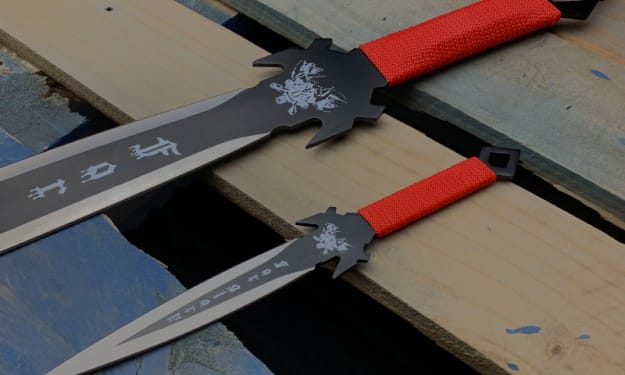Samurai Sword: Symbols of Honor, Craft, and Tradition!
Samurai Sword
The Samurai sword, sometimes called katana, is traditional Japanese weaponry distinguished by its well-crafted, single-edged, curved blades. These swords, which have their roots in feudal Japan, served as both necessary equipment and status symbols for samurai fighters. Every sword is painstakingly crafted from premium steel using a difficult folding and differential hardening process to provide unmatched flexibility, strength, and edge. In addition to other blades like the wakizashi and tanto, the katana was essential to the samurai's ceremonial and martial ceremonies.
The Samurai sword, which is revered as an extension of the warrior's soul, is a symbol of Japan's rich cultural legacy and martial arts customs. Historians, collectors, and martial arts fans from all over the world are fascinated by these swords. This sword, known for its elegance, craftsmanship, and deadly efficiency, is a symbol of Japan's rich cultural heritage. These weapons were more than mere tools of war; they were revered as extensions of the samurai's soul, embodying the virtues of honor, discipline, and mastery.
Major Types of Samurai Swords:
Samurai swords, also known as "nihonto," are prized for their artistry, cultural significance, and historical relevancy in Japan. A Samurai sword falls into three main categories, each identified by its function, design, and historical development.
Katana:
Of all these swords, the katana is arguably the most well-known. The katana is a weapon with a single-edged, curved blade that is usually between 60 and 80 cm long. In close combat, it was mainly used for slashing and cutting. The katana's soft curve makes it easy to move quickly and smoothly, which makes it perfect for simultaneous drawing and striking. The katana's blade, made of high-carbon steel, is well known for being both sharp and long-lasting. The samurai code of "bushido," which emphasizes honor, loyalty, and martial prowess, is embodied in it.
Wakizashi:
A shorter sword, the wakizashi's blade usually measures between thirty and sixty centimeters. Samurai wore it with their katana as a part of their daisho (pair of swords), and it functioned as a companion sword. The wakizashi was a multipurpose weapon that could be used for seppuku, or ritual suicide, as well as close-quarters fighting and ceremonial purposes. Its blade is slightly curved, akin to a katana, and, like its longer counterpart, it was made of premium steel for durability and sharpness.
Tanto:
At 15–30 cm in blade length, the tanto is the smallest of the three primary swords. Its main purpose in combat was as a dagger for thrusting and stabbing. Tanto blades are typically straight or gently curved, though they can be single- or double-edged. Samurai also wore tantos as a backup weapon, frequently being used for self-defense as well as practical tasks like chopping food.
Crafting and Designing of Samurai Sword
The painstaking process of creating a samurai sword, or "nihonto," combines age-old customs with cutting-edge metallurgical methods. Japan has several distinct stages in the art of making swords, especially katana, wakizashi, and tanto, each of which adds to the blade's durability, sharpness, and aesthetic appeal.
The first step in the process is choosing premium steel, which is frequently a blend of softer, more flexible steel for the spine and hard, high-carbon steel for the blade's edge. The steel undergoes meticulous heating, folding, and hammering procedures to eliminate impurities, smooth out the grain structure, and uniformly distribute carbon across the blade. Known as "tamahagane," this folding and forging process can involve hundreds or even thousands of layers, giving the surface of the blade a unique wood-grain pattern called "hada."
After being forged, the coarse blade is gradually shaped with a hammer and anvil to create the recognizable katana curve or the more angular wakizashi and tanto profiles. After that, the blade is heat-treated and quenched in either water or oil to harden the edge while keeping the spine flexible. This crucial balance is accomplished by carefully controlling the temperature.
The blade is polished (togishi) after it has been quenched to bring out its true sharpness and beauty. Using ever-finer abrasive stones, expert craftsmen painstakingly grind and polish the blade until its surface is perfect and mirror-like. This polishing guarantees the best possible cutting performance in addition to improving the blade's appearance.
The last stages involve making the samurai sword's pommel (kashira), guard (tsuba), and hilt (tsuka), which are frequently embellished with traditional materials like ray skin (samegawa) and wrappings made of silk or leather (tsuka-ito). The hilt is painstakingly fitted to the blade's tang (nakago), fastened with bamboo pegs (mekugi), and occasionally embellished with knots for decoration (menuki).
Samurai Sword - An Honor of Japanese Culture!
The "katana," or samurai sword, is a powerful representation of Japanese culture and history, representing centuries of skill, craftsmanship, and fighting prowess. The katana is revered for its exquisite design, deadly combat effectiveness, and profound spiritual and symbolic meaning. It also symbolizes the warrior class of samurai. These swords, which date back to medieval Japan, were made with blades that were incredibly durable and sharp thanks to the use of sophisticated metallurgical processes like folding and differential hardening.
These swords were treasured as heirlooms passed down through the generations, beyond their practical use in battle. They stood for honor, loyalty, and the samurai's unwavering devotion to bushido, the way of the warrior. As tangible relics that link contemporary Japan to its illustrious past of artistry and warrior ideals, these swords still enthrall enthusiasts and academics alike today. Every katana conveys a different tale about the samurai warrior's enduring influence on Japanese history and culture, as well as about their expert craftsmanship and spiritual discipline.
About the Creator
Mai Sophia
A Writer/blogger by day, a knife enthusiast and survivalist by night. I've reviewed a lot of products and have helped people make the right purchase
Enjoyed the story? Support the Creator.
Subscribe for free to receive all their stories in your feed. You could also pledge your support or give them a one-off tip, letting them know you appreciate their work.







Comments
There are no comments for this story
Be the first to respond and start the conversation.